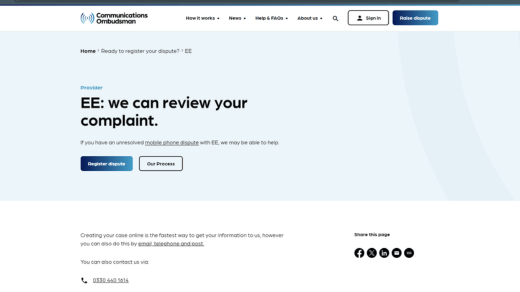
Comms Ombudsman
Handling complaints effectively is crucial for EE (formerly Everything Everywhere), one of the United Kingdom’s leading telecommunications providers. As a provider offering mobile, broadband, and other telecommunications services to millions of customers, EE faces a variety of complaints spanning different aspects of their services. Understanding the nature of these complaints and EE’s approach to addressing them is essential for maintaining customer satisfaction and loyalty.
Common Types of EE Complaints:
- Billing and Charges Disputes: Billing issues are a frequent source of complaints among EE customers. These may include disputes over incorrect charges, unexpected fees, unclear billing statements, or discrepancies in billing for services rendered. Customers often raise concerns about overbilling, charges for services they did not authorize, or failure to apply discounts correctly.
- Network Coverage and Service Quality: Complaints regarding network coverage and service quality are significant. Customers may experience dropped calls, poor signal reception, slow data speeds, or disruptions in service. Issues with network reliability, especially in rural or congested areas, impact the usability and reliability of EE’s services, affecting customer satisfaction.
- Customer Service Experience: Many customers express dissatisfaction with their interactions with EE’s customer service representatives. Complaints often cite long wait times to reach a representative, difficulty in obtaining accurate information, or perceived lack of empathy and understanding when addressing issues. Inconsistent service levels and ineffective problem resolution are common grievances.
- Technical Support and Device Issues: Technical support-related complaints arise when customers encounter problems with their devices or services. This may include difficulties with device setup, software updates, connectivity issues, or hardware malfunctions. Customers expect prompt and effective assistance to resolve these technical issues, which directly impact their ability to use EE services.
Contractual and Service Agreement Disputes: Disputes over contractual terms, service agreements, or changes in service conditions are also prevalent. Customers may dispute contract terms, unexpected changes in pricing or service plans, early termination fees, or failure to honor promotional offers. Clear communication and transparency in contractual matters are critical to avoiding misunderstandings.
EE’s Approach to Handling Complaints:
EE employs a structured approach to manage and resolve customer complaints effectively:
Accessible Complaint Channels: EE provides multiple channels for customers to submit complaints, including phone, email, online chat, and in-person visits to retail stores. This accessibility allows customers to choose the method that best suits their preferences and needs.
Complaint Resolution Process: EE follows a systematic complaint resolution process, which typically involves:
- Initial acknowledgment and assessment of the complaint.
- Investigation to gather relevant information and assess the merits of the complaint.
- Resolution attempts through negotiation, mediation, or providing solutions to address the customer’s concerns.
- Communication of outcomes to the customer, ensuring transparency in the resolution process.
Customer Support and Escalation Pathways: EE emphasizes the importance of customer support and escalation pathways for unresolved complaints. Customers have the option to escalate their complaints to senior representatives or specialized complaints handling teams for further review and resolution.
Transparency and Communication: EE strives to maintain transparency throughout the complaint handling process. They keep customers informed about the status of their complaints, expected timelines for resolution, and actions taken to address their concerns. Clear communication helps manage customer expectations and builds trust.
Feedback and Continuous Improvement: EE values customer feedback from complaints as a tool for continuous improvement. Analyzing complaint trends and root causes enables EE to identify areas for service enhancement, address systemic issues, and implement corrective measures to prevent recurrence.
Customer Feedback and Satisfaction:
Monitoring customer feedback and satisfaction metrics is essential for EE to gauge the effectiveness of its complaint handling processes. Positive resolutions and improved customer experiences contribute to higher levels of customer satisfaction, retention, and positive word-of-mouth referrals.
Conclusion:
In conclusion, addressing customer complaints effectively is crucial for EE to uphold its reputation and retain customer loyalty in the competitive telecommunications industry. By providing accessible complaint channels, following a structured resolution process, prioritizing transparency, and leveraging customer feedback for continuous improvement, EE aims to mitigate issues, enhance service delivery, and maintain high standards of customer satisfaction.
Check out Communications Ombudsman for more information.




